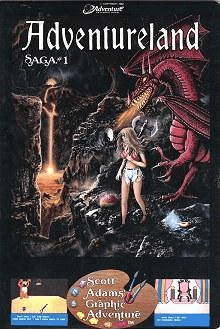Adventureland (video game)
| Adventureland | |
|---|---|
 | |
| Developer(s) | Adventure International |
| Publisher(s) | Adventure International |
| Designer(s) | Scott Adams |
| Platform(s) | TRS-80, Apple II series, Atari 8-bit, TI-99/4A, Commodore PET, Commodore 64, IBM-PC, Commodore VIC-20, ZX Spectrum, BBC Micro, Acorn Electron, Dragon 32/64, Exidy Sorcerer |
| Release date(s) | 1978 |
| Genre(s) | Interactive Fiction |
| Distribution | Cartridge, floppy disc, cassette |
Adventureland is an early, formative work of interactive fiction. It was written by Scott Adams, and was not only the first text adventure game to be commercially published and sold for the then-new home computers, but was the first commercially available adventure game of any kind for use on the systems.[1] Adventureland is a very characteristic, fantasy adventure, and the first in a series of twelve adventure games from Adams, and his company, Adventure International.[2]
Gameplay
Gameplay involves moving between the various locations found within the game, collecting found objects (and often subsequently using them, generally in another location), and the solving of puzzles.
The game commands take the form of either simple, two-word, verb/noun phrases, such as "Climb Tree," or one-word commands, such as those used for player character movement, including north, south, east, west, up, and down. Although the game has a vocabulary of about 120 words,[3] the parser only recognised the first three letters.[3] This meant that the parser occasionally identified a word incorrectly, but also that commands could be truncated, for example "lig lam" would be interpreted as "light lamp."
In order to complete the game, the player has to collect the thirteen lost artifacts: A statue of Paul Bunyan's blue ox, Babe, the jeweled fruit, the golden fish, a dragon's egg, a golden net, a magic carpet, a diamond necklace, a diamond bracelet, a pot of rubies, the "royal honey", a crown, a magic mirror, and a "firestone."
Unlike succeeding adventure games, Adventureland has no story or plot, being just a treasure hunt.
The game was available on a number of platforms, including the Apple II series of computers, and various computers released by Atari, Commodore International, and Texas Instruments. A cut-down, three treasure version entitled 'Adventure 0: Special Sampler' was also made available at a special low price.[4]
In 1982, Adventureland was re-released with graphics, thus enabling the player to view visible representations of the scenery and objects to be found within the game.[5]
Development
Adventureland, Adams' first program, is a slightly scaled-down, machine-language game similar to the “original” Adventure program.[6] The source code for Adventureland was published in SoftSide magazine in 1980[7] and the database format was subsequently used in other interpreters such as Brian Howarth's Mysterious Adventures series.[8]
References
- ↑ Griffin, Brad (March–April 1983). "Scott Adams Adventures 1–12". A.N.A.L.O.G. Computing (10).
- ↑ "Game Set Interview: Adventure International's Scott Adams", Game Set Watch, July 19th, 2006, retrieved on April 20th, 2009
- ↑ 3.0 3.1 "Great Scott". GamesTM (88). 2009. pp. 152–157.
- ↑ 0:Adventureland Demo "Scott Adams Classic Adventures," (retrieved on May 4th, 2009).
- ↑ "Scott Adams Classic Adventures", Adventureland, retrieved April 20th, 2009
- ↑ Herro, Mark (October 1980). "The Electric Eye". The Dragon (42): 42–43.
- ↑ Adams, Scott (July 1980). "Adventureland". SoftSide. p. 36. Retrieved 13 April 2015.
- ↑ Nelson, Graham (2001). The Inform Designer's Manual. Dan Sanderson. p. 358.